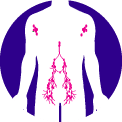
Coping physically with cancer
Lymphoedema is swelling of a part of the body. It can result from some cancers or their treatment. You can find out who is at risk of lymphoedema, how to lower your risk, and how specialists diagnose and treat lymphoedema.
Lymphoedema means a build up of lymph fluid that causes swelling in a part of the body. It can develop if there are problems with the lymphatic system.
Lymphoedema means a build up of lymph fluid that causes swelling in a part of the body. It can sometimes develop due to cancer or cancer treatment.
There are several things you can do to lower your risk of swelling (lymphoedema) after cancer treatment.
The most common symptom of lymphoedema is swelling. Some people also feel heaviness or aching in the affected area.
Doctors and specialist nurses can diagnose, test and assess lymphoedema.
Treatments to manage lymphoedema include skin care, exercise, weight management, compression therapy and manual lymphatic drainage (specialised massage).
There are ways to reduce your risk of infection when you have lymphoedema. See your doctor straight away if you think you have an infection. Early treatment is important.
Research helps us to find out more about conditions such as lymphoedema. Researchers are looking at what reduces the risk of developing lymphoedema and different ways of managing it.
Lymphoedema can affect you emotionally, physically, and practically. There are ways that you can help yourself and you can also get support from other people.
There are lots of organisations, support groups and helpful books to help you cope with lymphoedema caused by cancer or its treatment.
Last reviewed: 25 Apr 2023
Next review due: 25 Apr 2026

About Cancer generously supported by Dangoor Education since 2010. Learn more about Dangoor Education
What to ask your doctor about clinical trials.
Meet and chat to other cancer people affected by cancer.
Questions about cancer? Call freephone 0808 800 40 40 from 9 to 5 - Monday to Friday. Alternatively, you can email us.